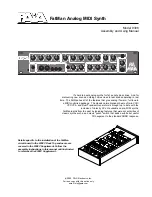
1 - If you hear from RTP-MIDI for the first time...
1.1 - What is RTP-MIDI ?
RTP-MIDI is a worldwide open and completely free standard, listed in RFC documents (RFC4695 / RFC6295).
This guarantees that anybody can use RTP-MIDI without needing to pay any license and ensures that no company
can claim RTP-MIDI to be its proprietary product. It is based on the well-known RTP protocol (listed as RFC3550
standard), which is based in turn on standard IP stack. This open approach allows RTP-MIDI to work natively on
virtually any platform (to be compared to proprietary protocols requiring bridge computers when used with tablets
for example).
RTP-MIDI does not necessarily relies on Ethernet and can be used over wireless links (iPad is using RTP-
MIDI in this way). However, the use of Ethernet guarantees extremely low latency over the complete network.
RTP-MIDI takes benefits of all RTP advantages, like clock synchronization, detection of lost packets, etc...
Moreover, RTP-MIDI provides a recovery mechanism, which allows a receiver to recover missing informations due
to lost packets without needing any retransmission.
RTP-MIDI is natively integrated in Mac OS X since 2006 (no need to install any driver on this platform), and
free Windows drivers are now available for all Windows platforms for XP, Vista, Windows Seven and Windows 8, in
32 and 64 bits versions. It runs also on iOS, Linux, Android, WinRT and it is supported by many projects like
Arduino, MIDIBox, etc...
Note that drivers are needed only to emulate MIDI ports from system point of view. Since RTP-MIDI is
running on the top of open, mature standards (IP / UDP / RTP), an application can run an RTP-MIDI engine
without needing to install any driver, like what is done in the VSTizer plugins from KissBox. RTP-MIDI is also
compatible with any existing router or network device, since it does not use any reserved/proprietary
communication code.
A legend about RTP-MIDI is the introduction of more latency than other solutions, because it is based on IP
technology. This is of course completely false, and extremely low latency can be easily be achieved with RTP-MIDI.
If you have any doubt about what can be done with RTP over Ethernet in terms of latency, just take a look to the
work done by Audio Engineering Society (AES) in the workgroup X192. They have demonstrated that it is possible
to have RTP/IP exchanges over a LAN network with 125 microseconds latency.
Another legend about RTP-MIDI claims that the configuration is awfully complex. In fact, the configuration of
a RTP-MIDI setup is exactly the same as the configuration process you used for your Internet access on your
computer. Yes, you need to use a configuration tool with RTP-MIDI... but solutions sold to be “100% Plug&Play and
with zero configuration” also need a configuration tool!
And do not trust also people claiming that RTP-MIDI exposes your computer to viruses because it uses IP.
Viruses do not spread because of a protocol, but because of security breaches in operating systems, whatever the
protocol used, even those which are not using IP.
The only thing we can not guarantee for now is the ability of RTP-MIDI to protect users against vampires...
But we are studying a solution to this problem... (that's a joke of course... vampires are naturally afraid of RTP-
MIDI, you have nothing to do to scare them when you use RTP-MIDI)
Page 6 of 33
Содержание CM-MIDI
Страница 1: ...KISSBOX CM MIDI USER S MANUAL Copyright c 2014 KissBox Page 1 of 33...
Страница 2: ...Page 2 of 33...







































